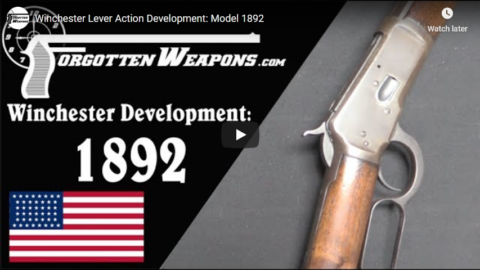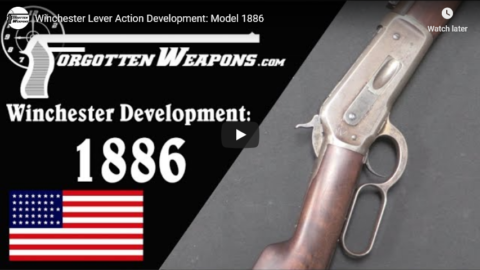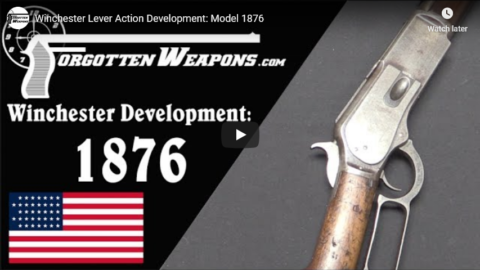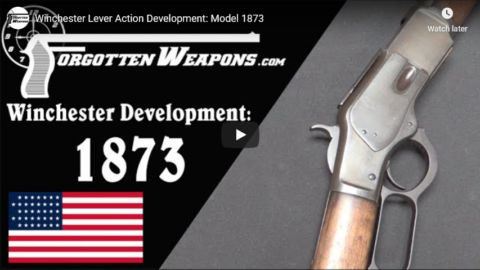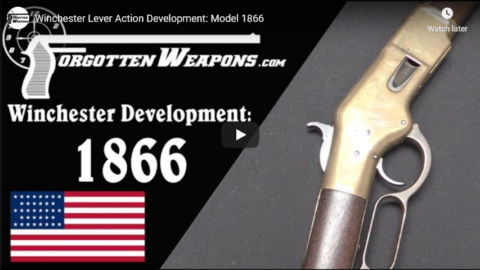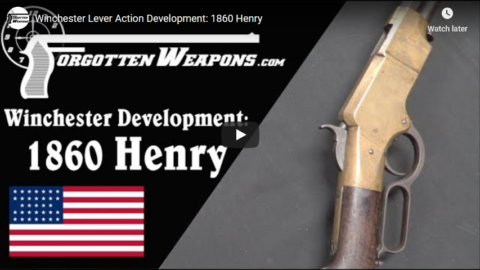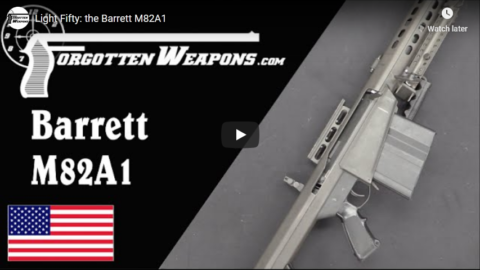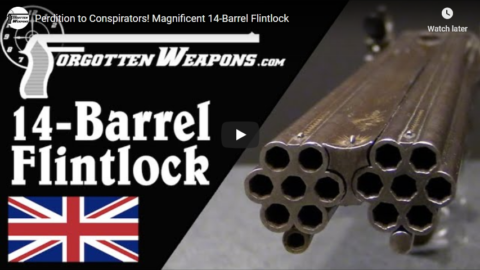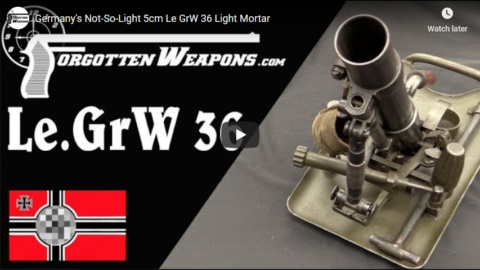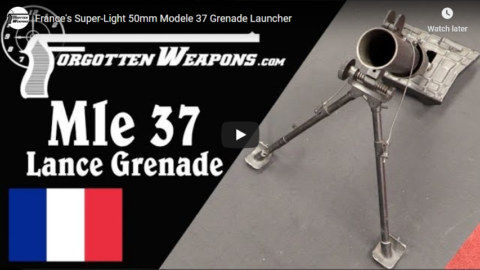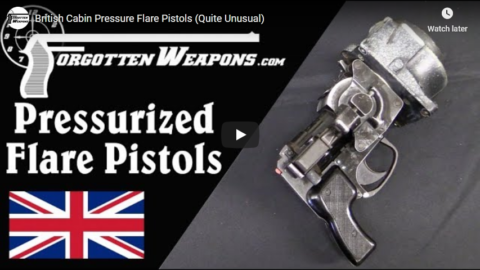Forgotten Weapons
Published 15 Jun 2017As the Model 1873 began to show its age, Winchester wanted a new rifle to take its place in the company catalog. Scaling down the Model 1886 to the pistol cartridges of the 1873 seemed like a fine option, and Winchester executives approached John Browning, offering him $10,000 if he could produce such a gun within 3 months, or $15,000 if he could do the job in two months. Browning’s response was to say that he would take $20,000 and have the rifle in company hands within 30 days — or else he would give it to them for free.
The $20,000 that Winchester paid him for the new rifle was well worth it, as the 1892 would become the best-selling Winchester rifle to that date, selling more than a million guns by the 1930s. It used the stronger and more cost-effective locking system of the 1886, while being chambered for the same cartridges as the 1873 — the .44 WCF (.44-40), .38 WCF (.38-40), and .32 WCF (.32-20), as well as a few new cartridges added over time.
Cool Forgotten Weapons merchandise! http://shop.bbtv.com/collections/forg…
http://www.patreon.com/ForgottenWeapons
If you enjoy Forgotten Weapons, check out its sister channel, InRangeTV! http://www.youtube.com/InRangeTVShow
October 17, 2020
Winchester Lever Action Development: Model 1892
October 14, 2020
Winchester Lever Action Development: Model 1886
Forgotten Weapons
Published 13 Jun 2017The Model 1886 was the first Winchester repeating rifle to improve on the original toggle locking system of the 1860 Henry, and it is also the first of John Moses Browning’s lever action designs. Browning met with Winchester executives to sell them his design for the Winchester 1885 single shot rifle, and mentioned that he was also working on a lever action repeating rifle that would be much stronger than the existing Model 1876. This was very interesting to Winchester, and they agreed to buy that design as well.
The new rifle used a pair of vertically sliding blocks to lock the bolt into the receiver upon firing, and allowed the weapon to safely chamber much more powerful rounds, up to and including the .50-100 Express. This rifle superseded the Model 1876 almost overnight, as it finally allowed a single rifle to have the power of the single shot buffalo rifles and the rapid firepower of the smaller caliber Winchesters.
Cool Forgotten Weapons merchandise! http://shop.bbtv.com/collections/forg…
http://www.patreon.com/ForgottenWeapons
If you enjoy Forgotten Weapons, check out its sister channel, InRangeTV! http://www.youtube.com/InRangeTVShow
October 11, 2020
Winchester Lever Action Development: Model 1876
Forgotten Weapons
Published 11 Jun 2017While the Model 1873 was a very popular rifle, its pistol caliber cartridge did leave a segment of the market unaddressed. Winchester wanted a rifle that could chamber the larger and more powerful cartridges popular with long range hunters, and the Model 1876 would be that rifle.
Early attempts to enlarge the 1873 action to use the .45-70 Government cartridge were unsuccessful, for two reasons. First, the cartridge in its 45-70-500 infantry configuration was simply too powerful for the toggle lock design that had been the core of all Winchester’s rifles back to the 1860 Henry. In addition, the elevator mechanism used to feed the rifle had to be sized to a specific (and fairly precise) overall cartridge length. The variety of different bullet weights used in the .45-70 did not affect use in single shot weapons, but did cause problems for Winchester’s repeater.
The solution was for Winchester to design a new round for its scaled-up Model 1876. This was the .45-75, and it used a relatively light bullet and a bottlenecked case similar to the general design of the .44 WCF from the Model 1873. This bottleneck improved obturation, preventing powder fouling from leaking around the cartridge case and into the working parts of the rifle. This was not strictly necessary though, as new chambering of the 1876 would be quickly added, including the .45-60; a straight-wall shortened version of the .45-70 Government round.
While it did not blow the doors off the factory like the 1873 had, the Model 1876 was a popular rifle with its intended audience, with tens of thousands of rifles sold to men including Theodore Roosevelt.
Cool Forgotten Weapons merchandise! http://shop.bbtv.com/collections/forg…
http://www.patreon.com/ForgottenWeapons
If you enjoy Forgotten Weapons, check out its sister channel, InRangeTV! http://www.youtube.com/InRangeTVShow
October 8, 2020
Winchester Lever Action Development: Model 1873
Forgotten Weapons
Published 9 Jun 2017With the Model of 1873, Winchester was able to address the major remaining weakness of the Henry and 1866 rifles — the cartridge. The 1873 was introduced in tandem with the .44 Winchester Center Fire cartridge (known more commonly today as the .44-40). This cartridge kept the 200 grain bullet from the .44 Henry Rimfire round, but used a brass case (as opposed to copper) and was able to increase the powder charge from 28 grains to 40, for a substantial increase in velocity.
In addition, the Model 1873 used a lighter steel frame and introduced a sliding dust cover on the top of the action to help keep out dirt and debris. The centerfire nature of the cartridge made it possible to handload ammunition when a commercial source was not available (Winchester sold the reloading tools). The 1873 was available with a wide variety of options, including barrel and magazine lengths, buttstock and grips, sights, and fancy options like engraving. It would prove to be a massively popular weapon both in the United States and abroad, cementing Winchester’s position as the premier manufacturer of American repeating rifles.
Cool Forgotten Weapons merchandise! http://shop.bbtv.com/collections/forg…
http://www.patreon.com/ForgottenWeapons
If you enjoy Forgotten Weapons, check out its sister channel, InRangeTV! http://www.youtube.com/InRangeTVShow
October 5, 2020
Winchester Lever Action Development: Model 1866
Forgotten Weapons
Published 7 Jun 2017While the Henry Repeating Rifle had been an serious leap forward in firearms capability, it was not without problems. The biggest single weakness of the Henry was its magazine. The tube magazine was open to dirt and debris, the follower could easily come to rest on the shooter’s hand or anything used as a rest and stop the weapon from feeding, and the while system was rather prone to being damaged.
These problems would all be addressed with the addition of Nelson King’s new loading gate idea, which allowed Winchester to omit the exposed follower entirely, solving a bunch of complaints all at once. The new system was more durable, more reliable, and allowed the rifle to be loaded without the awkward manipulation required by the Henry. The King improvement also allowed the addition of a wooden handguard, which was a welcome addition — it does not take very many black powder rounds for a barrel to become uncomfortably hot to the touch.
At the same time that these improvements were being made, company politics were taking shape to end Benjamin T. Henry’s involvement with the company. Henry attempted to take over ownership of the company because he felt he was not profiting as much as he should, but he had assigned his patent rights to Oliver Winchester in exchange for his contract to manufacture the guns. As a result, Winchester was able to create a new company (the Winchester Repeating Arms Company) with full rights to the design patents and sideline Henry.
The 1866 rifle, which was formally called simply the Winchester Repeating Rifle would continue to use the .44 Henry Rimfire cartridge, but would be made in a wider variety of configurations than the Henry had been, including carbine, rifle, and musket barrel lengths. It would prove to be a very popular rifle, and opened the path to further improvement, as it put the Winchester company on excellent financial footing.
Cool Forgotten Weapons merchandise! http://shop.bbtv.com/collections/forg…
http://www.patreon.com/ForgottenWeapons
If you enjoy Forgotten Weapons, check out its sister channel, InRangeTV! http://www.youtube.com/InRangeTVShow
October 2, 2020
Winchester Lever Action Development: 1860 Henry
Forgotten Weapons
Published 5 Jun 2017The Henry Repeating Rifle was a truly revolutionary development in firearms technology. It was not the first repeating rifle, but it was the best of a emerging class of new arms, reliable in function and very fast to shoot (much faster than the contemporary Spencers). The Henry used a simple toggle lock locking system, with a single throw of its lever performing all the elements necessary to reload and recock the action.
The Henry’s quick action was coupled with a 15-round magazine, more than double what the Spencer offered. It fired the .44 Henry rimfire cartridge, which threw a 216 grain bullet at about 1125 feet per second (this would change to 200 grains at 1200 fps within a few years). This was substantially less powerful than a heavy muzzleloader charge, but the volume of fire more than made up for it. Within 200 yards, the Henry could produce a devastating volume of fire.
The Henry was only produced for about 5 years (1862 – 1866), with about 12,000 manufactured in total. The Henry was made almost exclusively in a standard rifle pattern, with a 24 inch barrel. Some were later cut down into carbines, though. While the US military rejected the Henry for a variety of reasons, nearly all of the guns produced before the end of the war did actually see military service, with state units or individuals who supplied their own arms. In the few engagements where Henry rifles were present in substantial numbers, they proved to be a significant force multiplier.
Cool Forgotten Weapons merchandise! http://shop.bbtv.com/collections/forg…
http://www.patreon.com/ForgottenWeapons
If you enjoy Forgotten Weapons, check out its sister channel, InRangeTV! http://www.youtube.com/InRangeTVShow
September 29, 2020
Light Fifty: the Barrett M82A1
Forgotten Weapons
Published 10 Aug 2016Sold for $6,900.
The story of the development of the Barrett M82 .50 BMG semiauto rifle is really a neat story — much more interesting than most people probably expect, and reminiscent of many firearms development stories of the 1800s. Ronnie Barrett was working as a photographer in the late 70s, and became interested (perhaps obsessed?) with the idea of a semiauto .50 caliber rifle after a photo session with a Vietnam War jungle patrol boat (which was armed with a pair of M2 .50 caliber machine guns). At the time, the only civilian options for the .50 BMG cartridge were conversions of WWII antitank rifles like the Boys and PTRD.
Barrett, with basically no formal engineering background, sketched up a design and approached some machine shops for advice and assistance. He started working in his garage, and after a couple years had a functioning prototype completed. He sold the rifles commercially at gun shows and through publications like Shotgun News until making his first military sale in 1989, to the Swedish government. The following year he received an order from the US military, and sales took off from there.
Contrary to common expectation, the Barrett M82A1 is not really a “sniper” rifle — as a semiautomatic design with a recoil-operated action it’s potential accuracy is much less than that of a bolt action precision rifle — and this is amplified by the lack of a precision .50 BMG cartridge in US military service. In practice, the M82A1 will shoot about 3 MOA with normal ball ammunition, and about 1.5-2 MOA with good handloads. It is used primarily as an EOD rifle to detonate heavy-walled unexploded shells at a safe distance, and as an anti-material rifle to attack light vehicles and infrastructure at a long distance. These are relatively large targets, which require the large payload of a .50 BMG projectile but not the extreme accuracy of a true “sniper’s” rifle.
September 26, 2020
Perdition to Conspirators! Magnificent 14-Barrel Flintlock
Forgotten Weapons
Published 29 May 2020http://www.patreon.com/ForgottenWeapons
https://www.floatplane.com/channel/Fo…
Cool Forgotten Weapons merch! http://shop.bbtv.com/collections/forg…
Colonel Thomas Thornton was a wealthy and somewhat flamboyant character in England in the late 18th and early 19th century. He commanded a militia unit with which he had some disagreement, and which mutinied against his comment at Roborough Camp in 1795. Some years later, he commissioned this quite unique firearm from Dupe & Company of London.
The gun is a single stock with two flintlock actions, two triggers, and two clusters of seven .30 caliber rifled barrels each. Each trigger fires a complete barrel cluster simultaneously. In addition to the firepower of this very remarkable weapon, he also had it finished in a truly magnificent fashion, including the fantastic line “PERDITION TO CONSPIRATORS” on ons of the barrel clusters — clearly he harbored some resentment towards his unruly militia subordinates even years later.
In addition, he had a second stock made to fit just one lock plate and barrel cluster, for when 14 barrels might be a bit of overkill. That stock is even more decorated that the first, with beautiful wooden relief carvings and the motto “A Verite Gagner“, meaning something to the effect of “Truth From Victory”.
This gun is part of the Liege arms museum’s display of civilian arms, and I’d like to thank them for taking it out of their display so I could show it to you! If you are in Liege, stop in and see the museum:
Contact:
Forgotten Weapons
6281 N. Oracle #36270
Tucson, AZ 85740
September 24, 2020
PIAT: Britain’s Answer to the Anti-Tank Rifle Problem
Forgotten Weapons
Published 25 Nov 2017Sold for $3,163.
The British began World War Two with the Boys antitank rifle, but like all antitank rifles it rather quickly became obsolete. The replacement for it was adopted in 1942 as the PIAT – Projector, Infantry, Anti-Tank. This was a unique sort of weapon which fired a 3 pound (~1.35kg) hollow charge projectile using a combination of a massive spring and a firing charge much like a rifle grenade blank cartridge — a spigot mortar, really. The large (3.25″, 83mm) projectile was able to defeat almost any tank that would be developed during the war, as it could burn through 3-4 inches of hardened armor. However, it had a terrifyingly short effective range — 110 yards on paper and more like 50 yards in practice.
The PIAT would recock itself upon firing, but the initial cocking was something like a crossbow, requiring the shooter to brace their feet on the buttplate and pull the body of the weapon upwards, compressing the 200 pound (90kg) mainspring. When fired, the weapon has a pretty harsh recoil, although it did not have any flash or backblast like the American Bazooka did. By the end of the war more 115,000 PIATs had been made, and they would serve the British military into the 1950s, when they were replaced with more traditional rocket launchers.
http://www.patreon.com/ForgottenWeapons
Cool Forgotten Weapons merch! http://shop.bbtv.com/collections/forg…
If you enjoy Forgotten Weapons, check out its sister channel, InRangeTV! http://www.youtube.com/InRangeTVShow
September 21, 2020
The Iconic “Burp Gun” – Shooting the PPSh-41
Forgotten Weapons
Published 16 Dec 2017http://www.patreon.com/ForgottenWeapons
Cool Forgotten Weapons merch! http://shop.bbtv.com/collections/forg…
The Soviet PPSh-41 submachine gun is most distinctive for its very high rate of fire — approximately 1250 rounds/minute — and large drum magazine. What may come as a surprise to those who have not tried it is how this very high rate of fire does not actually make the weapon difficult to control or hold on target. In fact, the PPSh-41 is an easier SMG to shoot effectively than the later PPS-43, at least in my opinion.
The Soviets and the Germans made quite different choices in magazines and rate of fire with the PPSh and the MP40, but both turned out to be very good submachine guns. The glaring weak point of the PPSh are its magazines, and the difficulty in finding a drum that would run reliably in this particular example is why today’s shooting session is done with one of the 35-round stick magazines instead.
Thanks to Marstar for letting me examine and shoot their PPSh-41!
If you enjoy Forgotten Weapons, check out its sister channel, InRangeTV! http://www.youtube.com/InRangeTVShow
September 18, 2020
Germany’s Not-So-Light 5cm LeGrW 36 Light Mortar
Forgotten Weapons
Published 2 Sep 2018Sold for $18,400
http://www.patreon.com/ForgottenWeapons
Cool Forgotten Weapons merch! http://shop.bbtv.com/collections/forg…
The 5cm 5CM Leichter Granatwerfer 36 was the standard German light infantry mortar going into World War Two. It was designed by Rheinmetall-Borsig in the mid 1930s and adopted in 1936. It fired a 0.9kg / 2 pound mortar bomb with a range of up to 550 meters. In theory, it occupied the same role as the French Mle 1937 50mm light mortar — except it was far heavier than was practical, and substantially more complex to use. The LeGrW 36 weighed in at a hefty 31 pounds (14kg) – nearly four times as much as its French counterpart.
It was a striker fired design, with a trigger lever and thus did not fire immediately upon a round being loaded. It used adjustments in angle to determine range, with a constant projectile velocity (as opposed to venting a varying amount of propellent gas to adjust range). By the middle of the war, it was being pulled out of front-line use, as its weight and relative complexity made it impractical for its intended role.
If you enjoy Forgotten Weapons, check out its sister channel, InRangeTV! http://www.youtube.com/InRangeTVShow
September 15, 2020
France’s Super-Light 50mm Modele 37 Grenade Launcher
Forgotten Weapons
Published 1 Sep 2018Sold for $1,725
http://www.patreon.com/ForgottenWeapons
Cool Forgotten Weapons merch! http://shop.bbtv.com/collections/forg…
A new very light and portable mortar to replace the V-B rifle grenade was one of the facets of the French plan for rearmament and modernization after World War I. The concept for the weapons that would become the L.Gr. Mle 37 was first requested in 1924 — but like so almost all the other parts of that arms program, it was crippled by delays through the 1920s and 1930s. Only in the late 1930s when war was looking imminent did the program finally move forward.
The design, created by Captain Nahan of the Chatellerault arsenal, was adopted in 1937 and a whopping 21,950 were ordered in January of 1938 — and the order was quickly revised up to 50,000. However, only 2900 had been produced by the time of the armistice in June 1940. Production resumed in 1944, and the launcher did see use in Indochina. In addition, its 50mm grenade was the basis for the postwar French rifle grenades, as used on the MAS-36 LG 48, the MAS-44, and MAS-49 rifles. As fired from the mortar, the projectile weighed about one pound (0.4kg) and had a range of 80 to 460 meters, with an effective rate of fire up to 20 rounds per minute.
If you enjoy Forgotten Weapons, check out its sister channel, InRangeTV! http://www.youtube.com/InRangeTVShow
September 12, 2020
Shooting the ZB-26: A Jewel of an Interwar Light Machine Gun
Forgotten Weapons
Published 27 Oct 2017Sold for $34,500 (transferrable).
Today we have a chance to do some shooting with a ZB-26, a German-occupation 8mm light machine gun made at Brno in Czechoslovakia. The ZB-26 does not get nearly as much attention as LMGs made by the better known powers during the war, but it is an excellent weapon. In addition to being adopted by the Czech military, the gun was sold to about two dozen other countries and used in significant numbers by the Waffen SS.
As one would expect form its reputation, the ZB was smooth, reliable, and very controllable. For all the reasons discussed in yesterday’s history and disassembly video [here], it is a top notch firearm.
http://www.patreon.com/ForgottenWeapons
Cool Forgotten Weapons merch! http://shop.bbtv.com/collections/forg…
If you enjoy Forgotten Weapons, check out its sister channel, InRangeTV! http://www.youtube.com/InRangeTVShow
September 10, 2020
Could a Tankgewehr Really Take Out a British MkIV Tank?
Forgotten Weapons
Published 6 May 2017The Tankgewehr antitank rifle was developed by the Mauser company and adopted by the Imperial German military as an emergency measure to counter the introduction of tanks to the WW1 battlefield. The question is, did they really work? Could a 13.2mm AP bullet from a Tankgewehr really perforate the armor of a British tank? Well today we find out!
The armor on a British tank was steel plate of 6mm, 8mm, and 12mm thickness, through-hardened to Brinell 440-480. We have replicated this with a plate of AR450 (ie, Brinell 450) armor, which we will be shooting at a distance of 50 yards. The ammunition we are using is original 1918 production German AP, and the rifle is a Tankgewehr captured by Allied troops late in the war and brought home as a souvenir.
This video was only made possible with help from three very helpful folks:
MOA Targets provided the steel (and on short notice!): https://www.moatargets.com
Mike Carrick of Arms Heritage Magazine provided use of the T-Gewehr: https://armsheritagemagazine.com
Hayes Otoupalik provided the original ammunition: http://www.hayesotoupalik.com
Cool Forgotten Weapons merchandise! http://shop.bbtv.com/collections/forg…
http://www.patreon.com/ForgottenWeapons
If you enjoy Forgotten Weapons, check out its sister channel, InRangeTV! http://www.youtube.com/InRangeTVShow
September 8, 2020
British Cabin Pressure Flare Pistols (Quite Unusual)
Forgotten Weapons
Published 8 Oct 2018https://www.forgottenweapons.com/brit…
http://www.patreon.com/ForgottenWeapons
Cool Forgotten Weapons merch! http://shop.bbtv.com/collections/forg…
Signal flares were an important communications tool for aircraft during World War Two, and a multitude of flare pistol types exist with mounting brackets for aerial use. The introduction of pressurized fuselages made this a much more difficult proposition, however. These two flare pistols were designed by the British to maintain the pressurized seal of an aircraft body while still allowing firing and reloading through a pivoting mount and system of seals. I bet you haven’t seen something quite like these before!
Contact:
Forgotten Weapons
PO Box 87647
Tucson, AZ 85754If you enjoy Forgotten Weapons, check out its sister channel, InRangeTV! http://www.youtube.com/InRangeTVShow

